The following are seven key growth principles from Google’s Head of Growth: Ken Rudin.
Aptrinsic is now Gainsight PX! Gainsight PX helps your team deliver superior product experiences while Gainsight’s customer success platform helps to ensure customers are receiving business value from the product.
During our recent Mastering Product Adoption and Growth event, industry-renowned product leaders shared their insights into driving product growth. Here we summarize the seven principles outlined by Ken Rudin — Head of User Growth and Analytics at Google — on how to drive product growth.
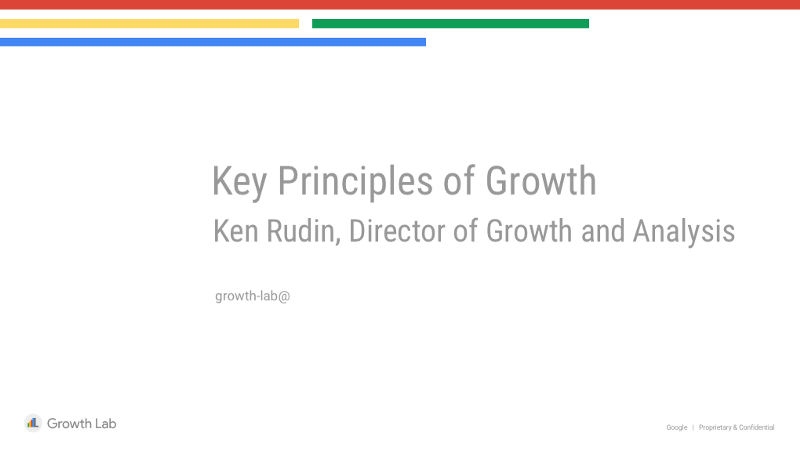
Growth is not a series of clever hacks, a silver bullet, or a killer feature. It is an iterative, data-driven process you go through again and again and again. Go through this process, and it will drive you to build better products that get more engagement from more users more often.
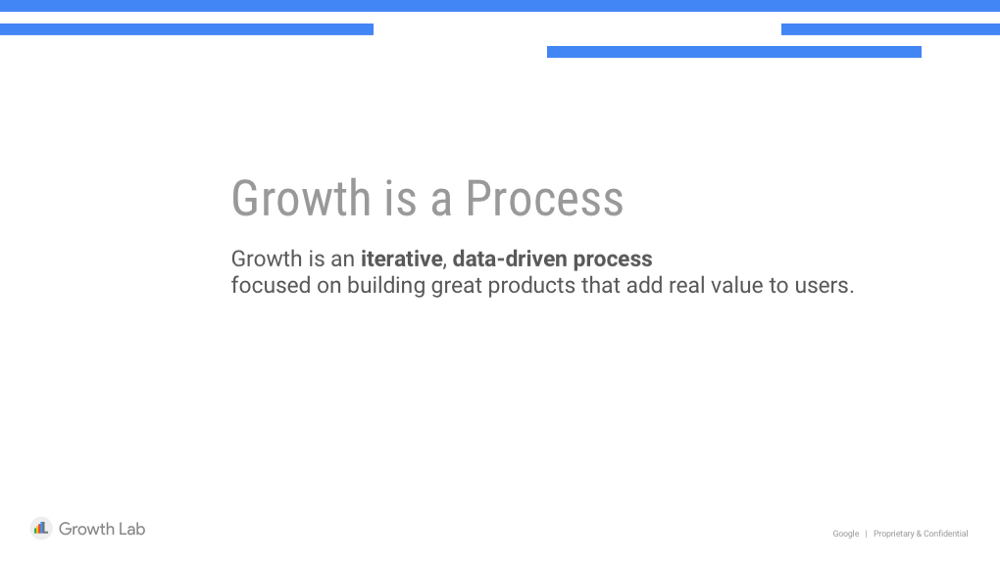
“Growth is an iterative, data-driven process focused on building great products that add real value to users.”
Here are seven principles Ken Rudin shared for driving that process and growth.
Principle 1: Define a single “North Star” metric and focus everyone on moving it
What is the single metric that you’re going to focus on? This is a hard discussion because there are many areas you want to grow — users, engagement, etc. Figure out the one metric that encapsulates the success of your product. Otherwise, you’ll launch a feature and measure the results and show growth. But that might not be what you need to grow.
The North Star metric answers the question: How do we define success? Plus, it helps track the impact of improvements to any part of your user funnel. In other words, if you improve awareness, acquisition, engagement, retention, or reactivation of users you’ve lost, your North Star metric should go up. Here are examples of the North Star metrics associated with various SaaS companies, per Ken.
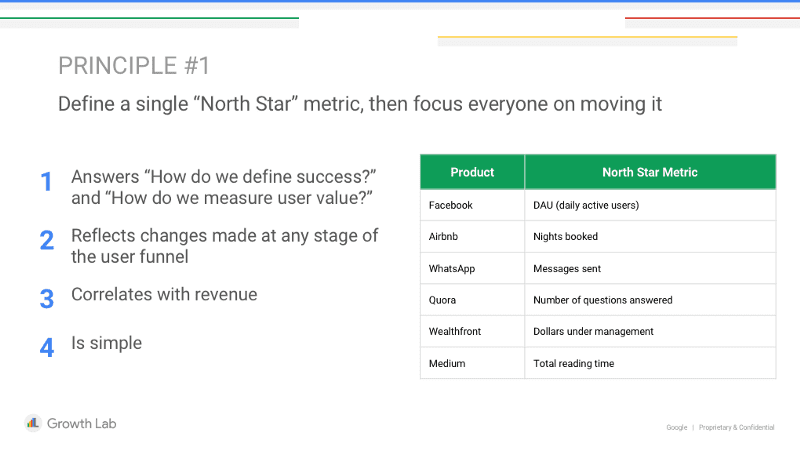
You need to figure out your North Star metric before you start pursuing growth. Otherwise you’ll have countless debates about prioritization because people will be focused on driving different metrics.
Principle 2: Drive retention before acquisition
Often, when product managers launch a product, they drive as many people as possible to use it. That’s not the way to do it. Until you have the right product, you’ll be bringing many people into your funnel who will quickly leak out. It’s essential to focus on retention first.
You know when you have good retention by tracking a retention curve. The graph below shows for a particular group of people — a cohort of users who start using your product on a particular day — what percentage of them came back the next day, and the next day, and the next day? If 100 people showed up on January 3, that’s 100% on that day. Out of those 100, how many showed up on January 4, and how many on the January 5, and so on, into February, March, etc.?
You will see a steep decline in the initial curve. Your retention curve won’t get entirely flat, but you need to get it pretty flat. Once you do, that’s when you’ve got product/market fit.
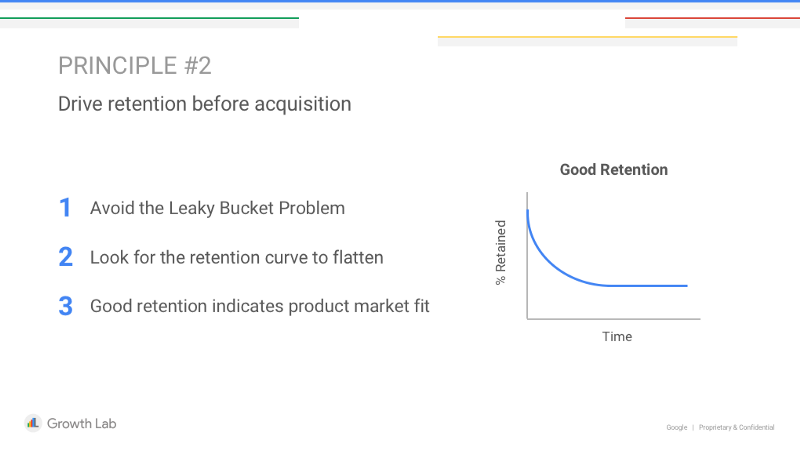
The factor that moves the retention curve line up or down more than anything else is how you define an active user. Do they have to open the app? Do they have to do something with the app? Do they have to be active that day? That week? How you define an active user doesn’t matter — it will vary by product. The key is to get retention flat. Once it’s flat, that’s your baseline and you focus on moving it up (i.e., increase retention).
Principle 3: Get the first mile right
To increase retention, it’s essential to focus on the first mile because typically apps lose 70% of users within the first 3-to-7 days of users trying the app. To improve this, you can do two things:
- Focus on activation, not just onboarding. Most product managers focus on what they want users to do once they are in the app, but activation is broader than that. Activation is getting users to a state where they are engaged and retained. It can take quite a while but understanding what it takes to get users to an engaged state changes your onboarding flow.
- Define your “Magic Moment.” Ken invited attendees to consider the old and newer versions of onboarding for Google Drive. In the older version, splash screens showed various benefits. Users would swipe through but the majority would leave the app. In fact, plenty of research shows that eliminating details about the benefits of your app as part of onboarding almost always increases retention. So the product team got rid of the onboarding flow in Google Drive.
Instead it now focuses on activation, mainly by identifying the things that correlate to retaining users. One of those for Google Drive is uploading a file, so the first thing you see when you open the app is a prompt to upload a file and information on how to do it. In other words, Google immediately gets users into an engagement and retention action.
As Ken reminds us, activation is really about driving people to your “Magic Moments.” These are the aha moments, when the user says, “I understand what this product is about, I understand the value, and I understand what’s unique about it.” In words, their experience of your product will bring them back to use it again.
Ideally, you identify multiple Magic Moments. You do that by looking at your data to determine what things are most heavily correlated with the users you retain.
Here’s an example in Google Photos.
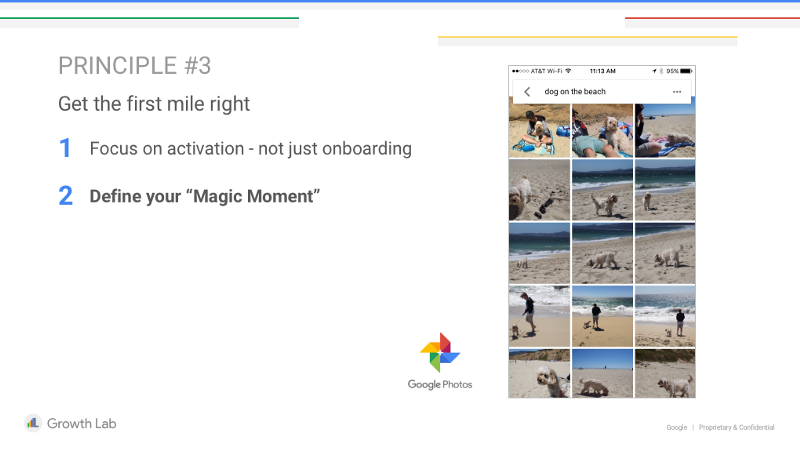
According to Ken, if Google positioned Google Photos as just another photo gallery, there’s no aha moment because the iOS photo app provides the same thing. The original aha moment for Google Photos was that you could search to pull up certain photos, without needing to tag your photos. That means you no longer needed to create photo albums to categorize and easily find specific photos. Now, Google Photos also finds and recommends photos with those you’ve shared with before.
Principle 4: Growth is a game of inches
Companies that consistently grow year over year drive that growth through hundreds of small product optimizations. Very rarely is their growth due to a killer feature.
There are hundreds and hundreds of little things you can do to improve engagement and retention. And because the vast majority of the things you try are not going to work or be effective, you need to try hundreds each year. That puts the odds of succeeding in your favor because it’s much easier to find winners out of hundreds of product tweaks than out of just one or two major features.
Think of it this way. Roll out 200 hundred product tweaks a year, and if 50 of those work and lead to 0.5% or 1% growth from each, you’ll get consistent growth.
Here’s an example Ken shared using Google Search. If you were in an area with poor Internet connectivity — such as an emerging market — and searched, you might see a message saying “You are not connected to the Internet” and that was it. It was not a good user experience. Google knew it could do a little better than that, like saying “Sorry, we can’t connect to the Internet right now but we’ll keep trying for a few minutes and will let you know if we can connect and will then show you the results.” Once a minute for the next five minutes, the app retries to see if there’s better connectivity. If so, a message pops up that the results are ready.
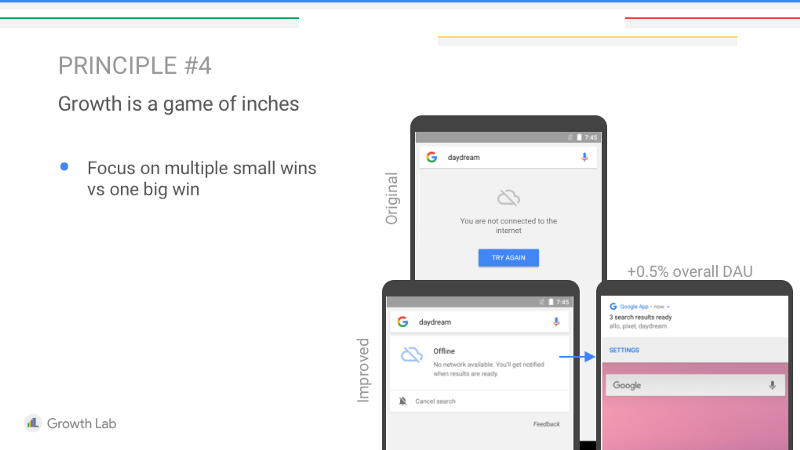
Google already had the functionality to do this. It just added a few lines of code to make this happen and, in turn, got 0.5% increase in Daily Active Users in India — a pretty big improvement in a country with a huge population.
According to Ken, eighty percent or more of Google’s growth in any particular year comes from these types of tweaks, not from some amazing new features it launches. The main takeaway: Focus on multiple small wins vs. one big win.
Principle 5: Increase discoverability
As product managers, we like to build new products and features. However, Ken says one of the best things we can do for growth of an existing product is focusing on the discoverability of existing features.
Usually, you build your most impressive features first. The longer your product is in the market, the more you build longer and longer tail features, which will affect fewer and fewer users. Rather than do that, focus on the existing features that are underutilized.
As an example, a Google Search product team is focused on building out sports capabilities. It already had coverage for major sports like basketball, baseball, football, cricket, tennis and so on. This team’s roadmap included sports like Sumo wrestling — not one of the world’s most popular sports.
What about soccer, the world’s most popular sport? Fewer than 30% of Google users had conducted a query for sports information, let alone soccer information. The notion was that 70% of the world didn’t know Google provides sports information, including live scores. So the product team decided to try to better surface that. Now when someone puts their cursor in the search box, they are shown a few suggestions of what they can search for. That drives awareness of sticky features that keep users coming back. So find and promote your sticky features that are underutilized.
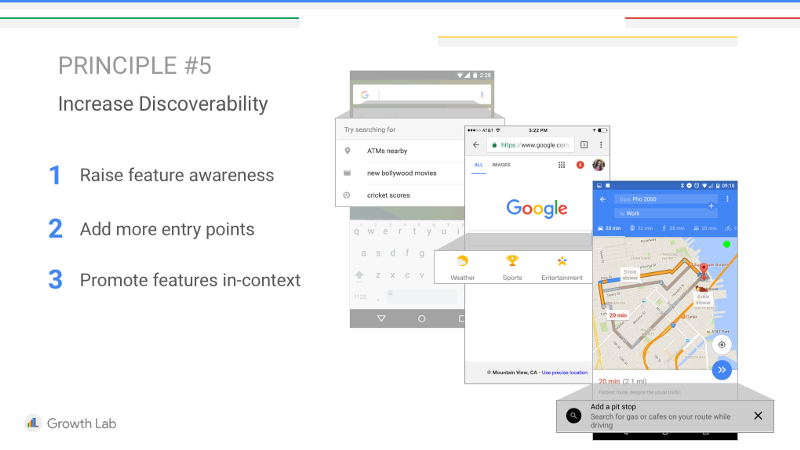
At the same time, add more entry points to those features. In other words, make it easier for users to find the front door to the features they already know about. The product team did this in Google Search by displaying “tap targets” for key features of interest. This allows users to simply tap to access information of interest rather than type in the search field. Because it’s easier to access that information, people engage with it more.
As Ken advises, if you have a new feature, don’t just display a splash page in your app announcing the new feature. Research and A/B tests show that this works poorly because people aren’t in the mindset of using that feature at that time. Plus, if someone starts using your app 6 or 12 months after you release a feature, you will probably be showing a different splash page about a different new feature by that point. That means they will have missed announcements about other new features.
Instead, Ken says to promote your features in context. Here’s an example from Google Maps when the company added a feature called Pit Stop. When navigating from point A to point B, people often want to know where they can find food and gas. Google initially promoted this through a splash page with poor results. Now when someone starts using Google Navigation, a pop-up asks if they would like to add a pit stop, when the user is in the right mindset. The usage and retention of that feature and of the app overall is now much higher.
Principle 6: Focus on your worst users, not your best
Following on what Jeetu Patel said about focusing on your marginal user, Ken recommends taking it a step further and focus on your worst users instead of your best. In other words, focus on the needs of your least engaged users.
In the graph below, the height of the bar shows how many people fall into that bucket. Each bucket shows how many people used the product 1 day per month, how many used it 2 days per month, how many 3 days per month and so on. This u-shaped curve is fairly common for SaaS apps.
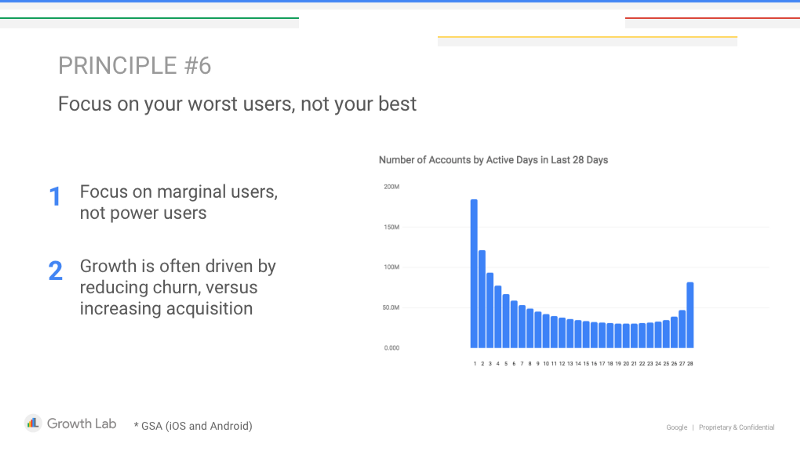
Ken says not to worry about the people on the right side of the curve — they use your product a lot and aren’t going anywhere. You tend to have more people on the left side of the curve so that’s where to focus.
Consider someone using your product 25 days per month. Getting them to use it two more days per month equates to an 8% increase in usage. On the other hand, if you can get someone using your product only two days per month to use it another two days per month, you’ve driven 100% increase in usage.
Growth comes from getting the users on the left side more engaged and making sure they don’t fall off, rather than getting those on the right to use your product a bit more. It doesn’t mean you should ignore those on the right — you need to keep them happy. But your biggest growth comes from moving those on the left side of the curve. In other words, growth is often driven by reducing churn versus increasing acquisition.
Principle 7: Growth begins and ends with data
Ken emphasized that growth is a data-driven process, meaning it begins and ends with data. You don’t simply run experiments and use analytics to figure out whether they positively or negatively impacted your metric. You start the process with analytics, going through a growth process bucketed into these three stages:
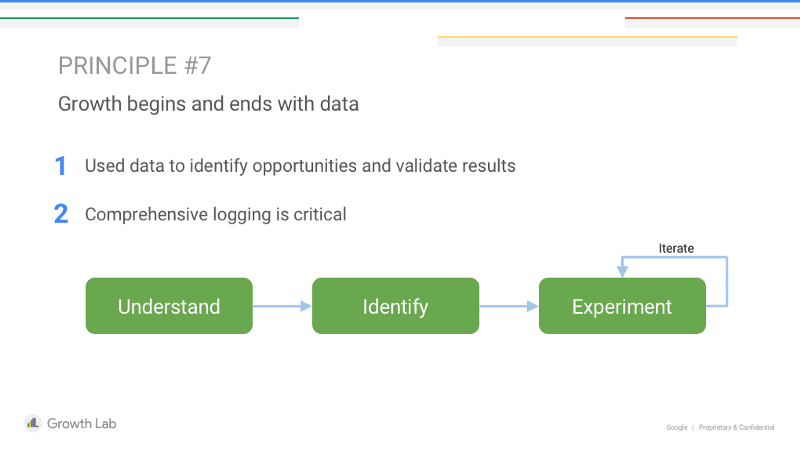
At each stage of this process, it’s essential to keep comprehensive logs of your data.
First, you use analytics to understand:
- Where your users come from
- How they’re getting into your product
- What your onboarding process looks like and how well it works
- What are people doing in your product
- How engaged they are
Based on that understanding, you can identify opportunities for growth. For example, what are the most engaging existing features that are woefully underutilized?
Then you need to run experiments and iterate. Don’t simply run an experiment and move on to the next one if that first experiment failed. If you believe your idea makes sense and is worth pursuing, run a few more experiments before you completely abandon the idea. If your experiment is successful, run more experiments because you can probably further optimize. In fact, if your first experiment works, consider yourself lucky. Because there are so many different ways to implement experiments, it’s incredibly lucky to choose the one way that works on your first try.
Put these seven principles into play, and you should be well positioned to drive better growth and retention.
Read the full “Mastering Product Experience: How to Deliver Personalized Product Experiences with Product-led Go-to-Market Strategy” book written by the Aptrinsic team: Nick Bonfiglio, Mickey Alon, and Myk Pono.
In this book, we share what we have learned about what it takes to succeed with a Software-as-a-Service (SaaS) company. We explain how to deliver a winning customer-centric experience strategy to your customers throughout the customer lifecycle, from acquisition to up-sell/X-sell. We show how to implement a faster and more effective product-led go-to-market strategy to meet changing customer expectations. And we share how to optimize Customer Acquisition Cost (CAC) and increase Customer Lifetime Value (CLV) by building better contextual relationships through personalized product-driven engagement.

